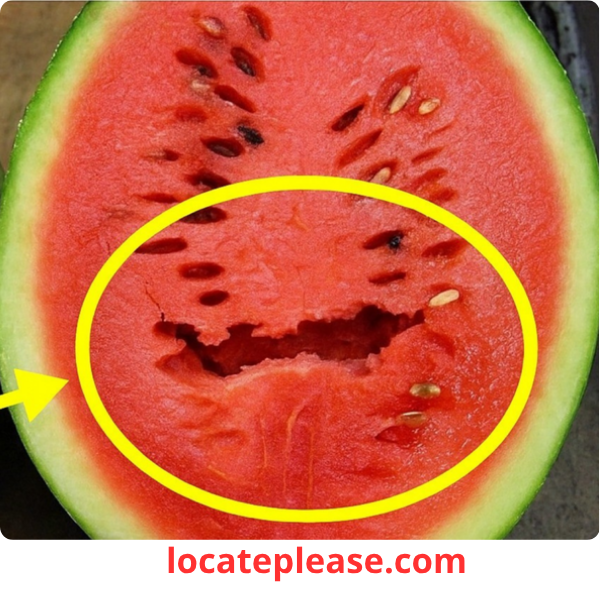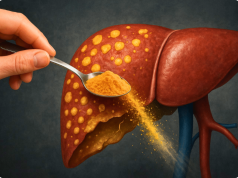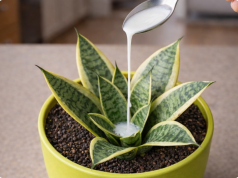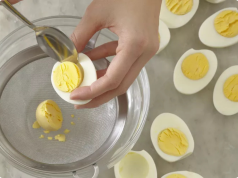On a scorching summer day, few pleasures beat the crisp, juicy bite of a chilled slice of watermelon. But what happens when you finally cut into that perfectly green-rinded melon — only to find deep cracks, hollow pockets, or gaping splits running through the red flesh?
It’s not just unappetizing — it could be a warning sign.
While a misshapen interior might seem like a harmless oddity, food safety experts say it could indicate a deeper issue — and in some cases, mean the fruit shouldn’t be eaten at all.
What Is “Hollow Heart” in Watermelon?
The condition you’re seeing is commonly known as “hollow heart” — a physiological disorder that causes internal fissures, cavities, or separation of the flesh within the fruit. Despite the name, it has nothing to do with the seeds or core — it’s a structural flaw that develops as the melon grows.
It’s not mold. It’s not rot — at least not yet. But it is a red flag.
What Causes Hollow Heart?
This condition isn’t caused by disease, but by stress during growth. Common triggers include:
- 🌡️ Fluctuating temperatures — sudden heatwaves or cold snaps during ripening
- 💧 Inconsistent watering — periods of drought followed by heavy irrigation
- 🌱 Overuse of nitrogen-rich fertilizers — which push rapid growth the fruit can’t sustain
- 🧬 Hybrid varieties — some modern watermelon breeds are more prone to this issue
When a watermelon grows too quickly on the outside while the inside lags, the flesh can pull apart, creating gaps and cracks that weren’t visible from the outside.
Is It Safe to Eat?
Here’s the hard truth: A watermelon with hollow heart isn’t automatically dangerous — but it’s risky.
Why?
- Increased Risk of Bacterial Growth
Those internal cracks create hidden pockets where moisture can collect — the perfect breeding ground for bacteria like Salmonella, Listeria, or E. coli, especially if the melon was exposed to contamination during handling or storage. - Hard to Detect Spoilage
Unlike surface mold, internal bacteria may not produce a foul smell or visible rot — especially in the early stages. By the time you notice something’s off, it might be too late. - Compromised Storage Integrity
If the melon experienced stress during growth or transport, its natural defenses may be weakened, making it more vulnerable to contamination — even if the rind looks perfect.
Food Safety Experts Say: When in Doubt, Throw It Out
The USDA and food safety professionals emphasize a simple rule:
If the inside of a watermelon looks abnormal — especially with deep cracks or hollow areas — don’t eat it.
While the fruit may still be technically edible in some cases, the risk of foodborne illness isn’t worth the gamble — especially for children, the elderly, pregnant individuals, or anyone with a weakened immune system.
How to Choose a Safe, High-Quality Watermelon
You can’t always prevent hollow heart, but you can reduce your risk by selecting your melon wisely.
✅ Look for a creamy yellow spot — this “ground spot” should be creamy, not white. It means the melon ripened on the vine. ✅ Choose a uniform shape — avoid melons with odd bulges or lopsidedness. ✅ Check the rind — it should be firm, smooth, and free of bruises, cuts, or soft spots. ✅ Give it a tap — a deep, hollow sound usually indicates ripeness (though not a guarantee of internal quality). ✅ Once cut, inspect the flesh — it should be firm, deeply colored, and free of gaps or mushy areas.
Bottom Line: Don’t Ignore the Inside
Hollow heart may start as a cosmetic flaw, but it can signal unseen vulnerabilities in your fruit. In the warm months — when bacteria multiply faster — taking a chance on a questionable melon could lead to stomach upset, food poisoning, or worse.
So if you slice open your watermelon and see something that looks like this:
🚫 Deep cracks
🚫 Gaping holes
🚫 Separated or spongy flesh
👉 Stop. Don’t taste it. Just throw it away.
Your body will thank you.
Remember: A beautiful rind doesn’t guarantee a safe interior. When it comes to watermelon — look beyond the surface.










